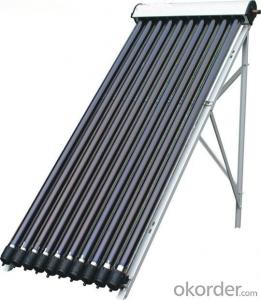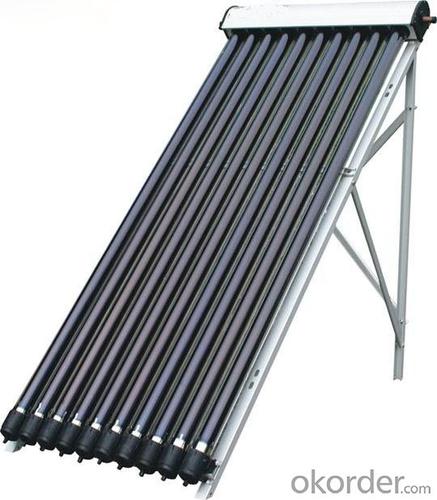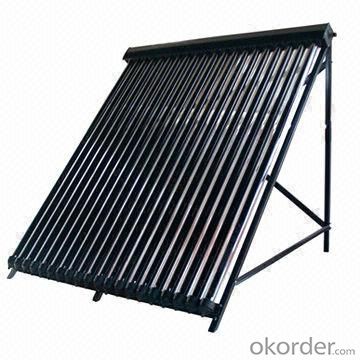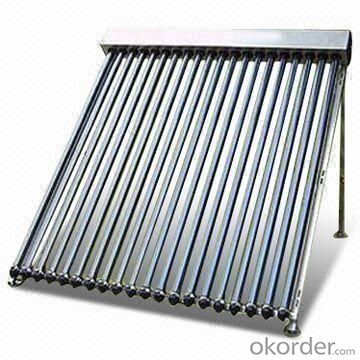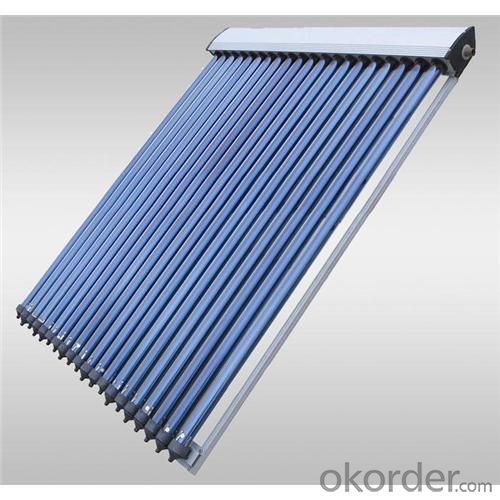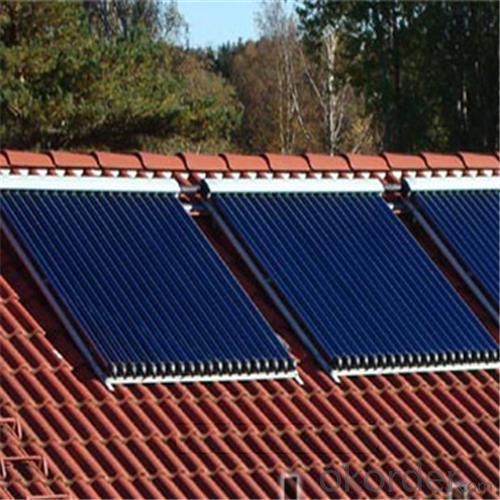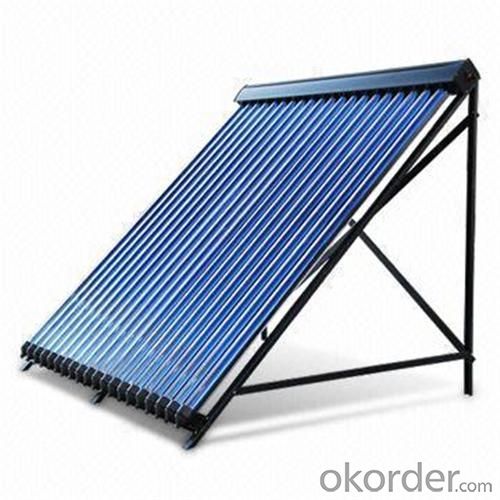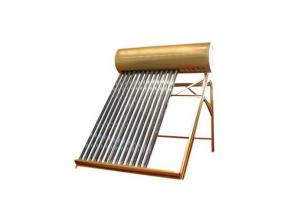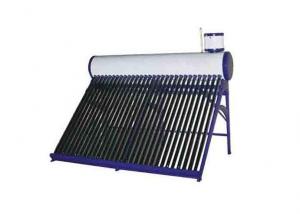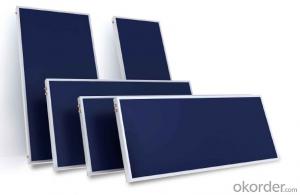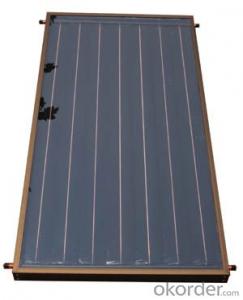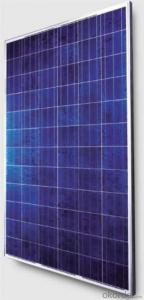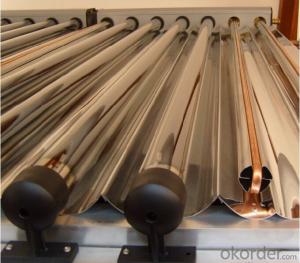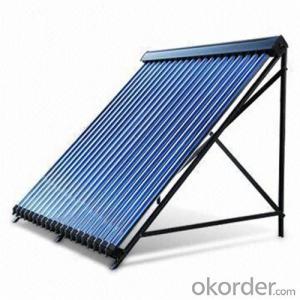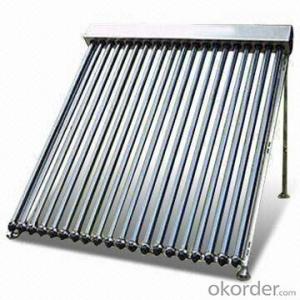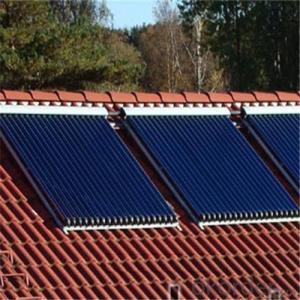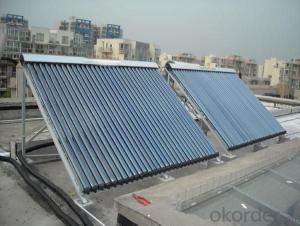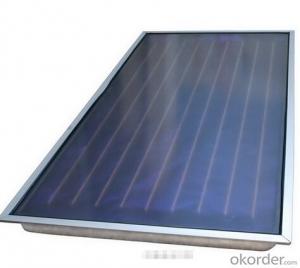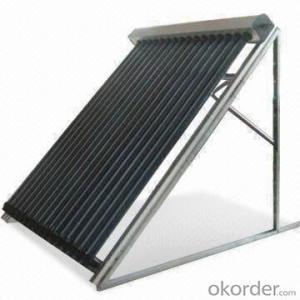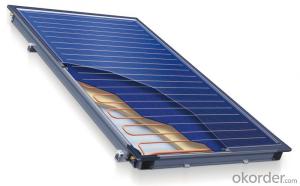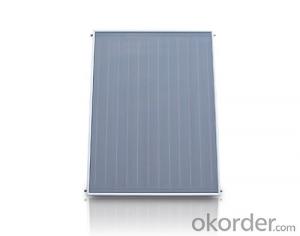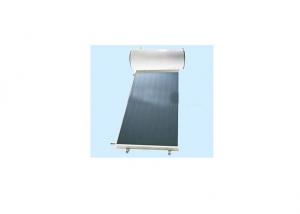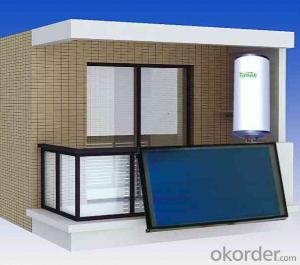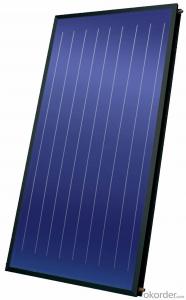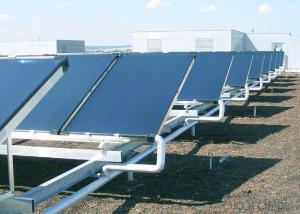Liquid Solar Collectors - Heat Pipes Solar Collectors for Rooftop with ROHS Certificate
- Loading Port:
- China main port
- Payment Terms:
- TT OR LC
- Min Order Qty:
- 5 set
- Supply Capability:
- 10000 set/month
OKorder Service Pledge
OKorder Financial Service
You Might Also Like
Specifications
manifold (inner) | red copper |
manifold (exterior) | aluminum alloy |
glass tube dimensions | 58mm * 1800mm |
daily efficiency | ≥55% |
heat preservation | 72 hours |
hail resistance | 25mm |
max pressure | 7 bar |
coating of vacuum tube | ALN/AIN-SS/CU |
heat pipe | anti-freezing > -35 degree |
certificate | Solar Keymark, EN12975,SRCC |
Serious Product
Models | L*W*H mm | Vacuum tube | Power output | Efficiency | Header mm | Frame | container loading 20FT/40HQ sets | Gross Weight kg |
SHC-8 | 1917*910*133 | 58*1800*8pcs | 939W | 0.668 | Φ35/1.0 | AL alloy | 185/445 | 27 |
SHC-10 | 1917*1130*133 | 58*1800*10pcs | 1189W | 159/385 | 33 | |||
SHC-12 | 1917*1350*133 | 58*1800*12pcs | 1440W | 149/358 | 40 | |||
SHC-15 | 1917*1680*133 | 58*1800*15pcs | 1815W | 120/290 | 49 | |||
SHC-18 | 1917*2010*133 | 58*1800*18pcs | 2191W | 100/242 | 59 | |||
SHC-20 | 1917*2230*133 | 58*1800*20pcs | 2442W | 87/210 | 66 | |||
SHC-22 | 1917*2450*133 | 58*1800*22pcs | 2692W | 83/202 | 72 | |||
SHC-24 | 1917*2670*133 | 58*1800*24pcs | 2943W | 77/188 | 79 |
Packaging & Delivery
Packaging Details: | Exporting Carton with big foaming protection |
Delivery Detail: | In 10-15 days |
Loading Quantity
Model | Tube | Tube Q.T.Y | Loading Q.T.Y/40HQ |
GSC15 | 58*1800mm | 15pcs | 315sets |
GSC18 | 58*1800mm | 18pcs | 265sets |
GSC20 | 58*1800mm | 20pcs | 248sets |
GSC22 | 58*1800mm | 22pcs | 225sets |
GSC25 | 58*1800mm | 25pcs | 200sets |
GSC30 | 58*1800mm | 30pcs | 168sets |
Principle of solar collector:
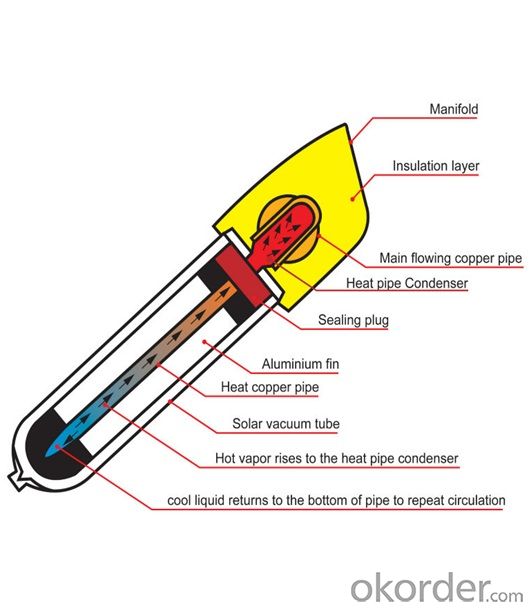
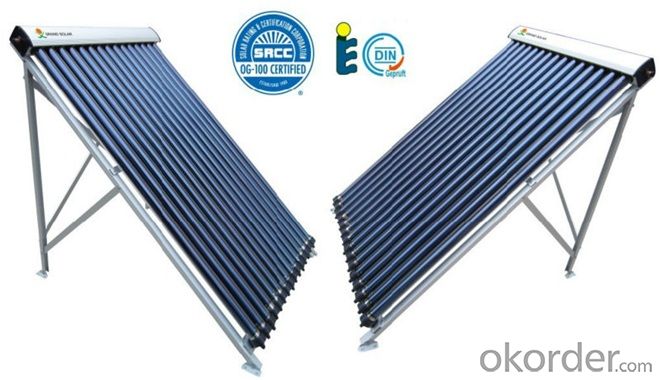
Solar collector details
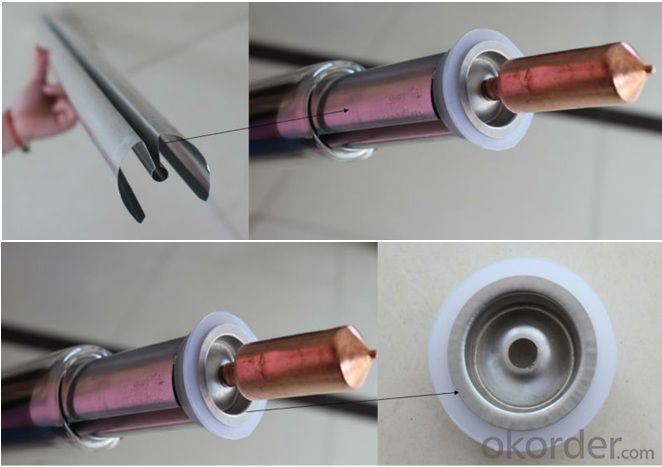
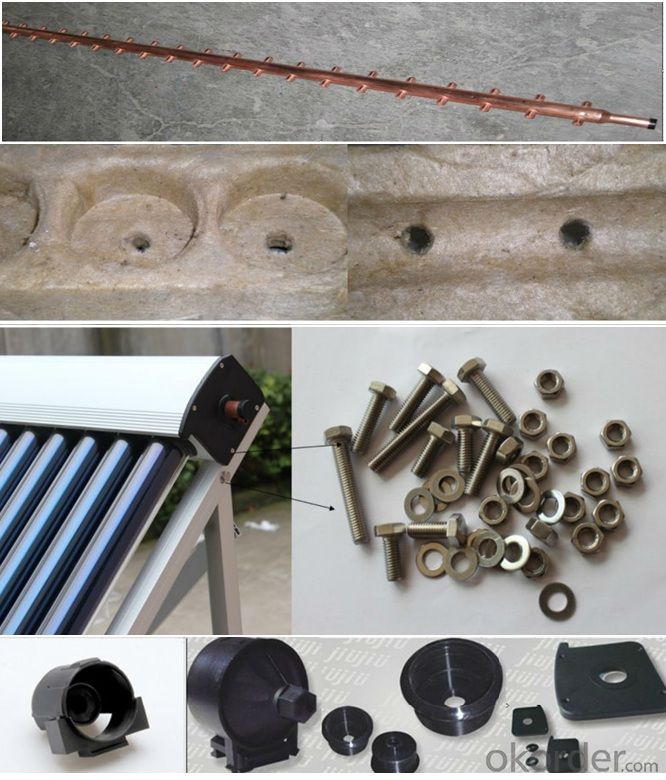
- Q: Can solar collectors be used for heating radiant floor systems?
- Yes, solar collectors can be used for heating radiant floor systems. Solar collectors absorb sunlight and convert it into heat, which can then be transferred to the radiant floor system through a heat exchange process. This can provide an efficient and sustainable way to heat the floors in a building using renewable energy sources.
- Q: Are solar collectors suitable for industrial parks?
- Indeed, industrial parks are well-suited for solar collectors. These parks usually possess expansive, unobstructed areas ideal for accommodating solar panels and collectors. The utilization of solar energy in these parks can yield electricity generation, water heating, and heating/cooling provisions for industrial structures. The inclusion of solar collectors in industrial parks presents a remarkable opportunity to curtail energy expenses and lessen reliance on fossil fuels, thereby establishing a sustainable and eco-friendly alternative. Moreover, solar energy systems can seamlessly integrate with current infrastructure, facilitating efficient energy administration and distribution throughout the industrial park.
- Q: How do solar collectors perform in extreme weather conditions?
- Solar collectors are designed to withstand and perform well in various weather conditions, including extreme ones. In cold weather, solar collectors are equipped with insulation and anti-freezing mechanisms to prevent damage from freezing temperatures. These mechanisms ensure that the fluid circulating within the collectors does not freeze and cause any cracks or damage to the system. In extremely hot weather, solar collectors are built to handle high temperatures without compromising their performance. They are made from durable materials that can withstand the heat and maintain their efficiency even in scorching conditions. Additionally, proper ventilation and cooling systems are integrated into the design to prevent overheating and maximize the system's overall performance. During heavy rain or snowfall, solar collectors are designed to shed water and prevent any water accumulation on the surface. This allows the panels to continue operating efficiently by minimizing any interference caused by water or ice. Furthermore, solar collectors are built to be sturdy and durable, capable of withstanding strong winds, hail, or other severe weather conditions. It is worth noting that extreme weather conditions may temporarily affect the output of solar collectors, as solar radiation may be reduced or blocked. However, modern solar collectors are designed to optimize energy absorption and conversion even in suboptimal conditions. Additionally, solar collectors can be installed at an optimal angle and orientation to maximize their performance throughout the year, taking into account the specific weather patterns of the region. Overall, solar collectors are engineered to be resilient and perform well in extreme weather conditions. They are subjected to rigorous testing and certifications to ensure their durability and efficiency under various environmental circumstances. With proper installation and regular maintenance, solar collectors can continue to generate clean and renewable energy even in the face of challenging weather conditions.
- Q: Can solar collectors be used in conjunction with other renewable energy systems?
- Certainly, solar collectors have the potential to be utilized alongside various other renewable energy systems. In reality, the combination of different renewable energy technologies can optimize the overall efficiency and dependability of the energy system. Solar collectors, also referred to as solar thermal systems, can be integrated with an array of other renewable energy systems like wind turbines, hydroelectric power plants, and geothermal systems. This amalgamation permits a more diverse and well-balanced energy generation portfolio. One method of merging solar collectors with other renewable energy systems is through the utilization of hybrid systems. To illustrate, solar collectors can be employed in conjunction with wind turbines to establish a hybrid renewable energy system that harnesses both solar and wind power. This can prove particularly advantageous in regions where the availability of sunlight or wind fluctuates. Another instance involves combining solar collectors with geothermal systems. Geothermal energy depends on the heat stored in the earth's crust, while solar collectors capture the sun's thermal energy. By integrating these two systems, it becomes feasible to achieve a more consistent and reliable energy supply, as geothermal energy can provide a stable base load while solar collectors can supplement during peak demand periods. Moreover, solar collectors can be effectively combined with other renewable energy technologies to enhance overall energy efficiency. For instance, surplus heat generated by solar collectors can be utilized to power absorption chillers for cooling or provide heat for industrial processes. In this manner, solar collectors can contribute to maximizing the utilization of renewable energy resources and minimizing waste. To summarize, solar collectors can be effectively combined with other renewable energy systems to create hybrid systems that optimize energy generation efficiency and reliability. By integrating different renewable energy technologies, we can establish a more sustainable and resilient energy infrastructure for the future.
- Q: Can solar collectors be used in solar thermal desalination?
- Solar thermal desalination can utilize solar collectors to convert seawater or brackish water into fresh drinking water using solar energy. These collectors, such as flat-plate collectors or parabolic troughs, capture and concentrate the sun's energy, which is then used to heat the water and generate steam. The steam is condensed to produce fresh water, while the concentrated brine is disposed of. Solar collectors play a crucial role in the process as they provide the necessary heat energy without relying on fossil fuels or electricity. By harnessing abundant and renewable solar energy, solar collectors make solar thermal desalination an environmentally friendly solution for addressing water scarcity in arid regions.
- Q: Can solar collectors be installed on pitched roofs?
- Yes, solar collectors can be installed on pitched roofs. In fact, pitched roofs are often preferred for solar panel installation as they provide optimum sun exposure and allow for efficient energy generation.
- Q: Are solar collectors suitable for office complexes?
- Yes, solar collectors are suitable for office complexes. Office complexes typically have large roof surfaces, which provide ample space for the installation of solar collectors. Solar collectors, such as solar panels, can generate renewable energy by converting sunlight into electricity. This can help reduce the reliance on grid-based electricity and lower energy costs for office complexes. Additionally, solar collectors can also be integrated into the design of office buildings, providing aesthetic value and showcasing the commitment towards sustainability. The use of solar collectors in office complexes aligns with the increasing trend of green buildings and sustainable practices in the corporate world. Furthermore, the installation of solar collectors can contribute to reducing carbon emissions and mitigating the environmental impact of office complexes. Overall, solar collectors are a suitable and beneficial option for office complexes, offering both economic and environmental advantages.
- Q: Can solar collectors be used for heating residential communities?
- Yes, solar collectors can be used for heating residential communities. Solar thermal systems can be installed in residential areas to collect and convert sunlight into usable heat energy. This heat can then be used for space heating and water heating in homes, reducing the reliance on traditional fossil fuel-based heating methods and promoting sustainability.
- Q: How do solar collectors perform in extreme temperatures?
- Solar collectors can perform well in extreme temperatures, although their efficiency may be affected. In hot climates, the increased temperature can cause a decrease in the efficiency of solar collectors. This is because the heat can cause the solar panels to heat up, leading to a decrease in the conversion of sunlight into electricity. Additionally, high temperatures can also impact the performance of other components of the solar collector system, such as the wiring and inverters. On the other hand, in extremely cold temperatures, solar collectors can still generate electricity, albeit at a reduced rate. Cold temperatures can cause a decrease in the overall efficiency of the solar panels due to the reduced amount of sunlight available during winter months. However, solar collectors are designed to withstand extreme weather conditions, including freezing temperatures, and are typically built with durable materials that can withstand these conditions. To mitigate the impact of extreme temperatures, certain measures can be taken. For example, in hot climates, proper ventilation or cooling systems can be installed to prevent overheating of the solar panels. In cold climates, the angle at which the solar panels are installed can be adjusted to maximize sunlight exposure and minimize snow accumulation. Additionally, regular maintenance and cleaning of the solar collectors can also help improve their performance in extreme temperatures. Overall, while extreme temperatures can affect the efficiency of solar collectors, they are still capable of generating electricity in both hot and cold climates. Proper installation, maintenance, and adjustments can help optimize their performance and ensure their longevity, even in challenging weather conditions.
- Q: Can solar collectors be used in regions with extreme temperatures?
- Yes, solar collectors can be used in regions with extreme temperatures. However, the performance and efficiency of the collectors may be affected by the extreme temperatures. It is important to consider the design and insulation of the collectors to ensure optimal functioning in such regions.
Send your message to us
Liquid Solar Collectors - Heat Pipes Solar Collectors for Rooftop with ROHS Certificate
- Loading Port:
- China main port
- Payment Terms:
- TT OR LC
- Min Order Qty:
- 5 set
- Supply Capability:
- 10000 set/month
OKorder Service Pledge
OKorder Financial Service
Similar products
Hot products
Hot Searches
Related keywords
